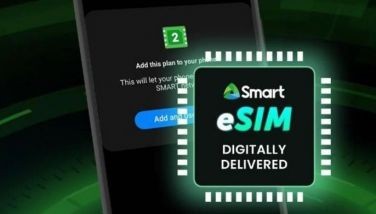SGH-X6760: A Samsung for today’s phone geek
April 22, 2006 | 12:00am
It’s hard to teach an old cellphone user new tricks. As someone who’s used to a series of increasingly archaic (and inherited) Nokia phones, I had mixed feelings about trying out a new model, such as the Samsung SGH-X670.
Sigh. Another set of keyboard commands to learn. Another set of menus to navigate. I have never understood why people become so hooked on their cellphones. For me, function is much more important than form. Namely, I want the damn thing to make and take calls easily; I don’t really care much about downloading ringtones, wallpaper photos or MP3s.
But that’s just me. And that’s just old-fashioned thinking. The Samsung X670 does have a lot to offer today’s phone geek. Features on this particular flip-top model include a camera and video function, an FM radio, an MP3 player, plus the usual Bluetooth and Web access, Java World, and something called SIM AT that "supports SIM Application Toolkit menus and provides news, weather, sports, entertainment and location services."
Other fun new features in the latest Samsung (just approved for sale in the US, by the way) are a stopwatch, a currency and temperature converter, a "world time" feature, and the latest Java-based games (mine has Forgotten Warrior, Arch Angel and Freekick for football enthusiasts).
And yet, if you just want to dial someone’s number real quick, what do you do? The Nokia user would just hit the "Contacts" menu on the right soft key. Check. Key in your first letter for a "Search." Check. After locating the number, you hit the upper center button, right? Wrong! This will merely show "Edit details" of the phone number you’re trying to dial.
Instead, modern phone users have to hit the green button. Most phones today have the confusing green and red phone icons to initiate and end calls. Why confusing? Because this adds a new button, whereas the old Nokia simply had a "C" button to cancel your calls. More complicated, less simple.
It may seem niggling and dinosauric of me to cling to the old Nokia ways. But consider some of the other "advances" on the Samsung keypad.
• The center "wheel" (well, more like a square with four active corners) took some getting used to but soon proved its usefulness. Resembling (as so many devices try to do nowadays) an iPod wheel though not in its operation, you can assign shortcuts to each of four corners, so this saves you the trouble of hitting five or six keys just to access the SMS function. Other default quick-keys were the calendar, radio and MP3 player. You can reset them, but unless you commit the reset location to memory, it’s a mind-scrambler to recall where it is. The center wheel comes into play when you hit "Menu." There, instead of simply scrolling down a list with your thumb, you must toggle between left, right, up, down and a center button to access the menu functions. This may appeal to PlayStation and X-Box users, but I find it a tad un-user-friendly. It slowed me down.
Actually, the center wheel, including the middle button (labeled "OK/i") is most useful for Web browsing, serving as a touchpad. I found this out because each time my thumb landed on the center button, I got an annoying "WAP disconnected" message. I hate when that happens.
• Too many toggles. The upper bar "soft keys" (above the green and red phone icons) are an additional pain. I keep hitting them accidentally, or forget that when I hit one with my thumb, it will take me right out of the menu I’m in and back to "Home." I missed the old "sub-menu" feel of the old Nokia; it allows you to change your mind, thumb back, and maybe reconsider your keystrokes.
• Call me tactile, but I like feeling the keys beneath my fingers. The older phones had raised digits – your fingers actually press down on something, making navigation easy even for a blind person. The smooth surface of recent cellphone keypads just makes mistakes easier.
• Punctuation. The Nokia, again, had the two left top and bottom keys of the dialing pad devoted to punctuation (1 and *). You could quickly move your thumb up or down to slip in a comma or question mark. Bizarrely, the Samsung places the second punctuation button under "0" instead; it’s a bit harder to locate with your thumb, and a bit counter-intuitive, I think.
Now for some good things about the Samsung SGH-X670. It’s a sleek, slim little package, a flip-top with a tough silver case that could probably survive a number of inadvertent drops (though I did not experiment with this). Its keypad is snazzy looking, and the 128 x 160 pixel 65k color display is pretty sharp (photo resolution with shots taken with the included camera is somewhat fuzzy, though). The MP3 player and Java World games can play without a headset, though the FM radio requires one. Sound quality is pretty good, considering.
I admit I could get used to all the little "extras" on the Samsung. It would take some re-learning – much like a Mac user switching over to a PC – but I eventually could master all the key idiosyncrasies of the Samsung, given enough time.
The calendar and alarm clock functions come in very handy while traveling. It’s nice to know what day it is at a glance, and I especially valued the loud, jingling tone of the alarm clock – it’s a life-saver when the hotel forgets to make your wake-up call.
The MP3 player is snazzy too. With a little light-show display, it puts out fairly good sound for such a small plastic box. Sending MP3s, photos and videos to other cellphone users is supposed to be a cinch, but I found I couldn’t even send a couple JPEGs to my wife’s phone, which was frustrating.
I’ll admit I did also enjoy the camera function. In addition to video recording, it also has a "quick-shot" feature, allowing you to click off six, nine or 12 rapid-fire shots (in normal or high-grade quality) in a row. Useful if you really want to make sure you got the candid camera moment. There are additional camera "effects" (emboss, black and white, negative, sepia, orange and aqua) for those wishing to diddle around with their photos further. And the sound effects of the camera are a hoot: the manual zoom button actually makes the sound of a camera zooming in; pad up the volume and it emits a nice electronic whir.
But then again, if I wanted a camera that also happens to make phone calls, I would probably buy one. And if I wanted high-grade photos, I probably wouldn’t actually rely on a cellphone camera.
But that’s just me.
Sigh. Another set of keyboard commands to learn. Another set of menus to navigate. I have never understood why people become so hooked on their cellphones. For me, function is much more important than form. Namely, I want the damn thing to make and take calls easily; I don’t really care much about downloading ringtones, wallpaper photos or MP3s.
But that’s just me. And that’s just old-fashioned thinking. The Samsung X670 does have a lot to offer today’s phone geek. Features on this particular flip-top model include a camera and video function, an FM radio, an MP3 player, plus the usual Bluetooth and Web access, Java World, and something called SIM AT that "supports SIM Application Toolkit menus and provides news, weather, sports, entertainment and location services."
Other fun new features in the latest Samsung (just approved for sale in the US, by the way) are a stopwatch, a currency and temperature converter, a "world time" feature, and the latest Java-based games (mine has Forgotten Warrior, Arch Angel and Freekick for football enthusiasts).
And yet, if you just want to dial someone’s number real quick, what do you do? The Nokia user would just hit the "Contacts" menu on the right soft key. Check. Key in your first letter for a "Search." Check. After locating the number, you hit the upper center button, right? Wrong! This will merely show "Edit details" of the phone number you’re trying to dial.
Instead, modern phone users have to hit the green button. Most phones today have the confusing green and red phone icons to initiate and end calls. Why confusing? Because this adds a new button, whereas the old Nokia simply had a "C" button to cancel your calls. More complicated, less simple.
It may seem niggling and dinosauric of me to cling to the old Nokia ways. But consider some of the other "advances" on the Samsung keypad.
• The center "wheel" (well, more like a square with four active corners) took some getting used to but soon proved its usefulness. Resembling (as so many devices try to do nowadays) an iPod wheel though not in its operation, you can assign shortcuts to each of four corners, so this saves you the trouble of hitting five or six keys just to access the SMS function. Other default quick-keys were the calendar, radio and MP3 player. You can reset them, but unless you commit the reset location to memory, it’s a mind-scrambler to recall where it is. The center wheel comes into play when you hit "Menu." There, instead of simply scrolling down a list with your thumb, you must toggle between left, right, up, down and a center button to access the menu functions. This may appeal to PlayStation and X-Box users, but I find it a tad un-user-friendly. It slowed me down.
Actually, the center wheel, including the middle button (labeled "OK/i") is most useful for Web browsing, serving as a touchpad. I found this out because each time my thumb landed on the center button, I got an annoying "WAP disconnected" message. I hate when that happens.
• Too many toggles. The upper bar "soft keys" (above the green and red phone icons) are an additional pain. I keep hitting them accidentally, or forget that when I hit one with my thumb, it will take me right out of the menu I’m in and back to "Home." I missed the old "sub-menu" feel of the old Nokia; it allows you to change your mind, thumb back, and maybe reconsider your keystrokes.
• Call me tactile, but I like feeling the keys beneath my fingers. The older phones had raised digits – your fingers actually press down on something, making navigation easy even for a blind person. The smooth surface of recent cellphone keypads just makes mistakes easier.
• Punctuation. The Nokia, again, had the two left top and bottom keys of the dialing pad devoted to punctuation (1 and *). You could quickly move your thumb up or down to slip in a comma or question mark. Bizarrely, the Samsung places the second punctuation button under "0" instead; it’s a bit harder to locate with your thumb, and a bit counter-intuitive, I think.
Now for some good things about the Samsung SGH-X670. It’s a sleek, slim little package, a flip-top with a tough silver case that could probably survive a number of inadvertent drops (though I did not experiment with this). Its keypad is snazzy looking, and the 128 x 160 pixel 65k color display is pretty sharp (photo resolution with shots taken with the included camera is somewhat fuzzy, though). The MP3 player and Java World games can play without a headset, though the FM radio requires one. Sound quality is pretty good, considering.
I admit I could get used to all the little "extras" on the Samsung. It would take some re-learning – much like a Mac user switching over to a PC – but I eventually could master all the key idiosyncrasies of the Samsung, given enough time.
The calendar and alarm clock functions come in very handy while traveling. It’s nice to know what day it is at a glance, and I especially valued the loud, jingling tone of the alarm clock – it’s a life-saver when the hotel forgets to make your wake-up call.
The MP3 player is snazzy too. With a little light-show display, it puts out fairly good sound for such a small plastic box. Sending MP3s, photos and videos to other cellphone users is supposed to be a cinch, but I found I couldn’t even send a couple JPEGs to my wife’s phone, which was frustrating.
I’ll admit I did also enjoy the camera function. In addition to video recording, it also has a "quick-shot" feature, allowing you to click off six, nine or 12 rapid-fire shots (in normal or high-grade quality) in a row. Useful if you really want to make sure you got the candid camera moment. There are additional camera "effects" (emboss, black and white, negative, sepia, orange and aqua) for those wishing to diddle around with their photos further. And the sound effects of the camera are a hoot: the manual zoom button actually makes the sound of a camera zooming in; pad up the volume and it emits a nice electronic whir.
But then again, if I wanted a camera that also happens to make phone calls, I would probably buy one. And if I wanted high-grade photos, I probably wouldn’t actually rely on a cellphone camera.
But that’s just me.
BrandSpace Articles
<
>
- Latest
Latest
Latest
February 22, 2024 - 3:17pm
February 22, 2024 - 3:17pm
December 11, 2023 - 11:00am
December 11, 2023 - 11:00am
November 23, 2023 - 4:35pm
November 23, 2023 - 4:35pm
October 16, 2023 - 5:00pm
October 16, 2023 - 5:00pm
Recommended



























